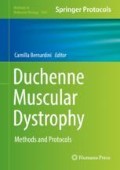Abstract
Duchenne muscular dystrophy (DMD) affects 1:3500–1:5000 male births, and is caused by X-linked mutations in the dystrophin gene, manifested by progressive muscle weakness and wasting due to the absence of dystrophin protein, leading to degeneration of skeletal muscle. DMD patients are clinically heterogeneous and the functional phenotype often cannot be correlated with the genotype. Therefore, defined reliable noninvasive biomarkers aiming at predicting if a given DMD child will progress more or less rapidly will be instrumental to better design inclusion of defined patients for future therapeutic assays. We recently showed that CD49d expression levels in blood-derived T-cell subsets can predict disease progression in DMD patients. Herein we describe in detail the methodology to be applied for defining, through four-color flow cytometry, the membrane expression levels of the CD49d (the α4 chain of the integrins α4β1 and α4β7) in circulating CD4+ and CD8+ T cell subsets. Since we have also shown that this molecule can also be placed as a potential target for therapeutics in DMD, we also describe the cell migration functional assay that can be applied to test potential CD49d inhibitors that can modulate their ability to cross endothelial or extracellular matrix (ECM) barriers.
References
Hoffman E, Brown R, Kunkel L (1987) Dystrophin: the protein product of the Duchenne muscular dystrophy locus. Cell 51:919–928
Yiu EM, Kornberg AJ (2015) Duchenne muscular dystrophy. J Paediatr Child Health 51:759–764
Falzarano MS, Scotton C, Passarelli C et al (2015) Duchenne muscular dystrophy: from diagnosis to therapy molecules. Molecules 20:18168–18184
Guiraud S, Aartsma-Rus A, Vieira NM et al (2015) The pathogenesis and therapy of muscular dystrophies. Annu Rev Genomics Hum Genet 2015(16):281–308
Mendell R, Campbell R-KL et al (2010) Dystrophin immunity in Duchenne muscular dystrophy. N Engl J Med 63:1429–1437
Rosenberg AS, Puig M, Nagaraju K et al (2015) Immune-mediated pathology in Duchenne muscular dystrophy. Sci Transl Med 7:299rv4. doi:10.1126/scitranslmed.aaa7322
Pinto-Mariz F, Carvalho LR, de Mello W et al (2010) Differential integrin expression by T lymphocytes: potential role in DMD muscle damage. J Neuroimmunol 223:128–130
Pinto-Mariz F, Carvalho LR, Araujo APQ et al (2015) CD49d is a disease progression biomarker and a potential target for immunotherapy in Duchenne muscular dystrophy. Skelet Muscle 5:45. doi:10.1186/s13395-015-0066-2
Barthélémy I, Pinto-Mariz F, Yada E et al (2014) Predictive markers of clinical outcome in the GRMD dog model of Duchenne muscular dystrophy. Dis Model Mech 7:1253–1261
Silva-Barbosa SD, Butler-Browne GS, de Mello W et al (2008) Human myoblast engraftment is improved in laminin-enriched microenvironment. Transplantation 85:566–575
Mendes-da-Cruz DA, Smaniotto S, Keller AC, Dardenne M et al (2008) Multivectorial abnormal cell migration in the NOD mouse thymus. J Immunol 80:4639–4647
Hoffman EP, Bronson A, Levin AA et al (2011) Restoring dystrophin expression in duchenne muscular dystrophy muscle progress in exon skipping and stop codon read through. Am J Pathol 179:12–22
Robinson-Hamm JN, Gersbach CA (2016) Gene therapies that restore dystrophin expression for the treatment of Duchenne muscular dystrophy. Hum Genet 135:1029–1040
Mah JK (2016) Current and emerging treatment strategies for Duchenne muscular dystrophy. Neuropsychiatr Dis Treat 12:1795–1807
McGreevy JW, Hakim CH, McIntosh MA, Duan D et al (2015) Animal models of Duchenne muscular dystrophy: from basic mechanisms to gene therapy. Dis Model Mech 8:195–213
Duan D (2015) Duchenne muscular dystrophy gene therapy in the canine model. Hum Gene Ther Clin Dev 26:57–69
Fernández O, Alvarenga MP, Guerrero M et al (2011) The efficacy of natalizumab in patients with multiple sclerosis according to level of disability: results of an observational study. Mult Scler 17:192–197
Piehl F, Holmén C, Hillert J et al (2011) Swedish natalizumab (Tysabri) multiple sclerosis surveillance study. Neurol Sci 31:289–293
Ghezzi A, Pozzilli C, Grimaldi LM et al (2010) Safety and efficacy of Natalizumab in children with multiple sclerosis. Neurology 75:912–917
Acknowledgments
This work was funded by the following institutions or funding agencies: Fiocruz, Faperj, CNPq, Capes (Brazil), Association Française contre les Myopathies (AFM), UPMC, Inserm and CNRS (France); Faperj-Sorbonne Conjoint Research Program (Brazil-France); FOCEM (Mercosur), United Parent’s Project for Muscular Dystrophies, Agence Nationale de Recherche (Genopath INAFIB), MyoAge (EC 7th framework program).
Author information
Authors and Affiliations
Corresponding author
Editor information
Editors and Affiliations
Rights and permissions
Copyright information
© 2018 Springer Science+Business Media LLC
About this protocol
Cite this protocol
Savino, W., Pinto-Mariz, F., Mouly, V. (2018). Flow Cytometry-Defined CD49d Expression in Circulating T-Lymphocytes Is a Biomarker for Disease Progression in Duchenne Muscular Dystrophy. In: Bernardini, C. (eds) Duchenne Muscular Dystrophy. Methods in Molecular Biology, vol 1687. Humana Press, New York, NY. https://doi.org/10.1007/978-1-4939-7374-3_16
Download citation
DOI: https://doi.org/10.1007/978-1-4939-7374-3_16
Published:
Publisher Name: Humana Press, New York, NY
Print ISBN: 978-1-4939-7373-6
Online ISBN: 978-1-4939-7374-3
eBook Packages: Springer Protocols

